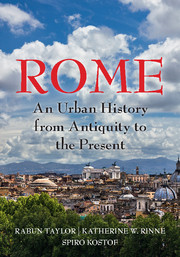Book contents
- Frontmatter
- Dedication
- Epigraph
- Contents
- List of Illustrations
- Acknowledgments
- Map
- INTRODUCTION
- 1 A BEND IN THE RIVER
- 2 A STORYBOOK BEGINNING
- 3 IDEOLOGICAL CROSSFIRE
- 4 BIG MEN ON THE CAMPUS
- 5 RES PUBLICA RESTITUTA
- 6 MEMORIALS IN MOTION: SPECTACLE IN THE CITY
- 7 THE CONCRETE STYLE
- 8 REMAKING ROME'S PUBLIC CORE: I
- 9 REMAKING ROME'S PUBLIC CORE: II
- 10 CRISIS AND CONTINUITY
- 11 RUS IN URBE: A GARDEN CITY
- 12 ADMINISTRATION, INFRASTRUCTURE, AND DISPOSAL OF THE DEAD
- 13 MAPPING, ZONING, AND SEQUESTRATION
- 14 TETRARCHIC AND CONSTANTINIAN ROME
- 15 TROPHIES AND TITULI: CHRISTIAN INFRASTRUCTURE BEFORE CONSTANTINE
- 16 WALLS MAKE CHRISTIANS: FROM FOURTH TO FIFTH CENTURY
- 17 A TALE OF TWO ROMES
- 18 THE ROME OF GOTHS AND BYZANTINES
- 19 CHRISTIAN FOUNDATIONS
- 20 FROM DOMUS LATERANI TO ROMANUM PALATIUM
- 21 THE LEONINE CITY: ST. PETER'S AND THE BORGO
- 22 VIA PAPALIS, THE CHRISTIAN DECUMANUS
- 23 THE URBAN THEATERS OF IMPERIUM AND SPQR
- 24 HOUSING DAILY LIFE
- 25 CHAOS IN THE FORTIFIED CITY
- 26 THE TIBER RIVER
- 27 HUMANIST ROME, ABSOLUTIST ROME (1420–1527)
- 28 PLANNING COUNTER REFORMATION ROME
- 29 PROCESSIONS AND POPULATIONS
- 30 MAGNIFICENT PALACES AND RHETORICAL CHURCHES
- 31 NEOCLASSICAL ROME
- 32 PICTURING ROME
- 33 REVOLUTION AND RISORGIMENTO
- 34 ITALIAN NATIONALISM AND ROMANITÀ
- 35 A CITY TURNED INSIDE OUT
- Glossary of Persons, Places, and Terms
- Works Cited
- Index
18 - THE ROME OF GOTHS AND BYZANTINES
Published online by Cambridge University Press: 05 July 2016
- Frontmatter
- Dedication
- Epigraph
- Contents
- List of Illustrations
- Acknowledgments
- Map
- INTRODUCTION
- 1 A BEND IN THE RIVER
- 2 A STORYBOOK BEGINNING
- 3 IDEOLOGICAL CROSSFIRE
- 4 BIG MEN ON THE CAMPUS
- 5 RES PUBLICA RESTITUTA
- 6 MEMORIALS IN MOTION: SPECTACLE IN THE CITY
- 7 THE CONCRETE STYLE
- 8 REMAKING ROME'S PUBLIC CORE: I
- 9 REMAKING ROME'S PUBLIC CORE: II
- 10 CRISIS AND CONTINUITY
- 11 RUS IN URBE: A GARDEN CITY
- 12 ADMINISTRATION, INFRASTRUCTURE, AND DISPOSAL OF THE DEAD
- 13 MAPPING, ZONING, AND SEQUESTRATION
- 14 TETRARCHIC AND CONSTANTINIAN ROME
- 15 TROPHIES AND TITULI: CHRISTIAN INFRASTRUCTURE BEFORE CONSTANTINE
- 16 WALLS MAKE CHRISTIANS: FROM FOURTH TO FIFTH CENTURY
- 17 A TALE OF TWO ROMES
- 18 THE ROME OF GOTHS AND BYZANTINES
- 19 CHRISTIAN FOUNDATIONS
- 20 FROM DOMUS LATERANI TO ROMANUM PALATIUM
- 21 THE LEONINE CITY: ST. PETER'S AND THE BORGO
- 22 VIA PAPALIS, THE CHRISTIAN DECUMANUS
- 23 THE URBAN THEATERS OF IMPERIUM AND SPQR
- 24 HOUSING DAILY LIFE
- 25 CHAOS IN THE FORTIFIED CITY
- 26 THE TIBER RIVER
- 27 HUMANIST ROME, ABSOLUTIST ROME (1420–1527)
- 28 PLANNING COUNTER REFORMATION ROME
- 29 PROCESSIONS AND POPULATIONS
- 30 MAGNIFICENT PALACES AND RHETORICAL CHURCHES
- 31 NEOCLASSICAL ROME
- 32 PICTURING ROME
- 33 REVOLUTION AND RISORGIMENTO
- 34 ITALIAN NATIONALISM AND ROMANITÀ
- 35 A CITY TURNED INSIDE OUT
- Glossary of Persons, Places, and Terms
- Works Cited
- Index
Summary
BY AROUND 400, ROME ALREADY HAD THE BEGINNINGS OF AN AMBIVALENT environmental order, part classical and part medieval. There was a splendid urban frame accompanied by history, legends, and administrative apparatus. The Lateran now headed a system, distinct from the older one but symbiotic with it, comprising a network of parish churches each with its own clergy, and beyond the walls, cemeteries with their own important pilgrimage centers and suburban organisms. Much of this structure was in place by the fifth century.
Rome's imperial religious infrastructure had been largely neutralized: temples were decommissioned; cults suppressed; cult statues moved to public spaces to be regarded simply as art; and treasure, in part at least, removed. A marginal group, the Goths, had settled in Rome on the rundown edges of the Esquiline and Caelian Hills establishing their ecclesiastical tradition, Arianism, a fringe Christian sect considered heretical and often persecuted. The Jews may have been similarly concentrated, probably in the Transtiberim. Meanwhile Mithraism had closed shop and its places of worship had been abandoned or reappropriated for Christian use. The seeds of religious absolutism in a once-tolerant multifaith city were evidenced by the institution of an administrative structure as early as the mid-third century that divided Rome into seven ecclesiastical regions, whereby the Church was now organizing the entire city for its own purposes as if its assumption of civil jurisdiction were only a matter of time.
If Christianity was neutralizing or superseding polytheistic Rome's religious architecture, the same could not be said for the remaining pagan structures, including the imperial centers of government, which still functioned more or less as before. These were the Palatine; the Curia on the Forum and its dependencies, which had been the base of the Senate for a thousand years; and the offices of the urban prefecture, perhaps now in the Basilica of Maxentius, which had absorbed all the once-independent city services including the police, grain and oil distribution centers, and the water and public works commissions. Christian Rome needed this still-functioning administrative network as much as imperial Rome had. The Senate was now more concerned with the city's daily operation than with foreign policy. And since the imperial bureaucracy had left, a skeleton staff oversaw the once-bustling Palatine.
- Type
- Chapter
- Information
- RomeAn Urban History from Antiquity to the Present, pp. 170 - 179Publisher: Cambridge University PressPrint publication year: 2016



